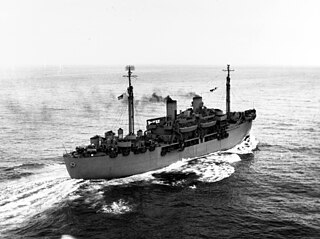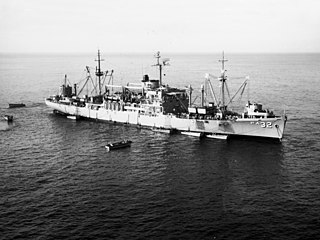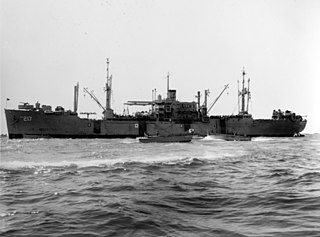 Cambria underway, c. 1943 | |
| History | |
|---|---|
| Name | USS Cambria |
| Namesake | Cambria County, Pennsylvania |
| Laid down | 1 July 1942, as SS Sea Swallow (built as C3-S-A2 hull, MC 271) |
| Launched | 10 November 1942 |
| Christened | by Clara Scally Griffin, wife of William H. Griffin. |
| Acquired | 4 May 1943 |
| Decommissioned | 30 June 1949 |
| Renamed | USS Cambria (APA-36), 10 November 1943 |
| Reclassified | From Transport (AP-81) to Attack Transport (APA-36), 1 February 1943 |
| Stricken | 1 September 1971 |
| Honours and awards | Six battle stars for World War II |
| Fate | Sold 7 September 1971, scrapped 1972 |
| General characteristics | |
| Class and type | Bayfield-class attack transport |
| Displacement | 8,100 t.(lt), 16,100 t.(fl) |
| Length | 492 ft 6 in (150 m) |
| Beam | 69 ft 6 in (21 m) |
| Draught | 26 ft 6 in (8.1 m) |
| Propulsion | one General Electric geared turbine; two Combustion Engineering D-type boilers; one propeller; 8,500 Design shaft horsepower (6.3 MW) |
| Speed | 18 knots (33 km/h). |
| Boats & landing craft carried | 12 x LCVPs; 4 x LCMs (Mk-6); 3 x LCP(L)s (MK-IV) |
| Capacity | 200,000 cubic feet (5,700 m3), 4,700 tonnes (4,600 long tons; 5,200 short tons) |
| Complement |
|
| Armament | 2 x single 5 in (127 mm) 38 cal dual purpose gun mounts, one fore and one aft; 2 x single 40 mm AA gun mounts; 2 x twin 40 mm AA gun mounts; 18 x single 20 mm AA gun mounts |
USS Cambria (APA-36) was a Bayfield-class attack transport acquired by the U.S. Navy for service in World War II. She was named after Cambria County, Pennsylvania
Contents
- World War II Pacific Theatre operations
- Invasion of the Marshall Islands
- Invasion of Saipan
- Invasion of Leyte
- Invasion of Lingayen Gulf
- Invasion of Okinawa
- After hostilities
- Post-World War II operations
- Suez crisis
- Beirut mission
- End of service
- Awards
- References
- External links
Cambria was launched 10 November 1942 as SS Sea Swallow by the Western Pipe and Steel Company, San Francisco, California, under a Maritime Commission contract; sponsored by Mrs. W. Griffin; acquired by the Navy 4 May 1943; placed in partial commission the same day, sailed to New York for decommissioning and conversion to an attack transport; and recommissioned 10 November 1943.
USS Cambria was taken out of service in 1970.



















